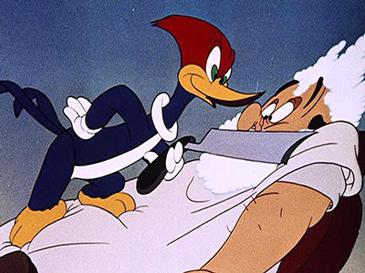Woody Woodpecker, the cackling, anthropomorphic bird became popular as one of the screwball cartoon characters of the 1940s. He appeared in cartoons produced by the Walter Lantz animation studio which were distributed by Universal Pictures. Woody was created by Lantz and storyboard artist Ben “Bugs” Hardaway in 1940. He was originally voiced by Mel Blanc, the man who provided the voices of Bugs Bunny, Daffy Duck, Tweety Bird, and many others. After Blanc finished voicing Woody, Ben Hardaway took over, and later Lantz’s wife Grace Stafford voiced the character.
The funny fowl got his own theme, “The Woody Woodpecker Song,” in 1947. The song was written by musicians George Tibbles and Ramey Idriss and made good use of the character’s famous laugh. The 1948 recording by Kay Kyser of Harry Babbitt laughing over vocalist Gloria Wood became one of the biggest hit singles of the year.
Lantz used the song for the first time in the short Wet Blanket Policy. It became the first and only song from an animated short to be nominated for the Academy Award for Best Song. Lantz adopted the song as Woody’s theme which paved the way for immense popularity. Fans loved the song so much that it led to Woody Woodpecker fan clubs, theaters started holding Woody matinee shows, and young boys adopted the Woody Woodpecker hairstyle.
Blanc, however, did not like it. The song and Woody Woodpecker cartoons used the laugh Blanc recorded as a cornerstone for the character. Despite the fact that he had only recorded three shorts as the voice of Woody, his laugh became a stock sound effect which was used in all of the subsequent shorts. Blanc sued Lantz over the use of his recording, but he lost. Lantz settled with Blanc outside of court after Blanc had filed an appeal. Lantz stopped using Blanc’s Woody Woodpecker laugh as a stock effect in the early 1950s, but his voice could still be heard saying “Guess who?” during the opening over every cartoon during the run of the series.











